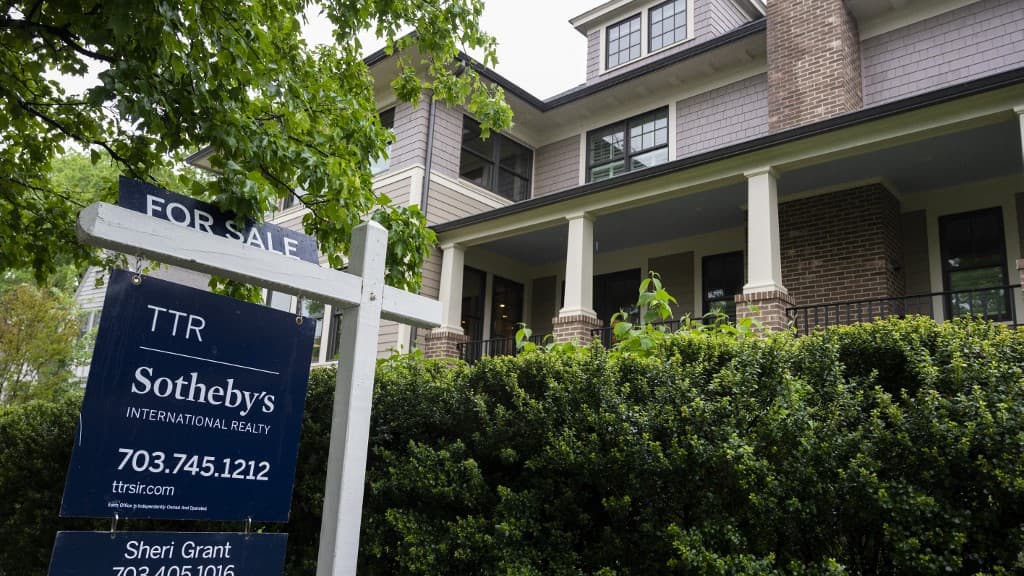New homes have never been so expensive across the Atlantic. And such a price increase in a few months is almost unheard of in recent American history. But a rise in rates is looming on the horizon.
The surge in real estate prices is not calming for the moment in the United States. The median price of a new home rose another 18.7% year on year in September, according to the latest data released Tuesday by the US Census Bureau, the US Census Bureau. It now stands at $ 408,800. In other words, half of the houses are sold more expensive, the other half costs less.
We were barely $ 330,000 before the outbreak of the pandemic. Since the start of the crisis in March 2020, the price of new homes has exploded by 25%! A dizzying leap also observed in the old, which is traditionally less expensive. The median price of an older home was worth $ 352,800 in September (+ 13.3% year on year), according to figures from the National Association of Realtors (NAR) America. And again, it is 26% more than before the arrival of Covid-19.
Of course because the United States is a huge market. In San Francisco, for example, an older home is now worth an average of more than $ 1.5 million, according to Zillow. In New York, it’s half the price, at almost $ 730,000. In Seattle, it will be more like $ 875,000. In Detroit, it’s only $ 60,000. And here we are only talking about very large cities, there is a lot of difference depending on local markets.
Of course, the variations from one city to another are huge because the United States is a very large and heterogeneous market. In San Francisco, for example, a typical older home is now worth an average of more than $ 1.5 million, according to Zillow. In New York, it’s half the price, at almost $ 730,000. In Seattle, it will be more like $ 875,000. As for Detroit, it’s only $ 60,000. And here we are only talking about very large cities.
A historic soar in the United States
Such price increases are almost unheard of in the history of the United States. Admittedly, the prices of new homes are quite volatile in the United States. But when you look at the official data from the 1960s, it’s extremely rare to have several months in a row above 18 or 20%, as has been the case since last April. We are talking here about evolution over one year, for example from September 2020 to September 2021.
Since 1964, it has only happened 15 times that the increase in prices over one year is greater than that observed last month. And again, 4 of these 15 flights took place this year.
In fact, we have three major periods that are similar to what we have experienced in recent months in America. First, there are the years 1973/1974 when the price increase is very strong. It is the first oil shock combined with the end of the gold standard for the dollar in 1971. And real estate prices soar, some months to more than 20% over a year. Rebelote or almost in 78/79 with the second oil shock. The hikes are a bit smaller but last a bit longer.
And finally, we have an episode in 1986 – early 1988. It therefore begins before the stock market crash of October 1987. In 1985, the great world powers agree to lower the dollar, which ends up after a few minutes. months at its lowest level since… 1979 precisely. Inflation is racing, the United States is forced to raise interest rates. This will precipitate the stock market crash but the real estate market will not calm down until mid-1988.
So, how to explain such a blaze of the stone? There are several factors. “First of all, the Fed’s ultra-accommodating monetary policy has enabled households to access rather low mortgage rates”, analysis for BFM Immo Frédéric Rollin, investment strategy advisor at Pictet Asset Management. Interest rates on home loans are still close to their all-time low, around 3% over 30 years. In addition, “on the buyers’ side, savings have been made because incomes have not plunged thanks to social assistance, while consumption was low when the pandemic arrived. Also, there is always an excess. savings compared to the pre-crisis trend of nearly 2.4 trillion dollars in the United States, ”adds Frédéric Rollin.
A phenomenon visible all over the world
“Then, the default rate in US real estate fell sharply, with good credit quality. There is therefore a propensity of households to be able to pay higher prices. However, working from home weighs on demand real estate for larger dwellings, with a bedroom or an office to work in. As in the United States, the houses are mainly built of wood, the price of wood has increased sharply, “notes Frédéric Rollin. In fact, the price of lumber had risen enormously to reach a record high of nearly $ 1,700 per 1,000 board feet last May. It has since fallen to nearly $ 600. The United States had been affected by major fires and had compensated by scooping wood all over the planet.
“The real estate pressure was therefore very strong on the rise. Especially since there was a shortage of goods. For a while, we could not build. The stocks of new houses were then at their lowest,” emphasizes also Frédéric Rollin.
It is not moreover a specifically American phenomenon. Real estate prices are soaring almost everywhere in developed countries. In South Korea, prices rose by nearly 12% over the first 9 months of the year, compared to the same period of 2020. Several European countries also show very significant increases: + 10.9% over one year in the second quarter for Germany, according to Eurostat data. + 15.6% for Denmark, + 12.8% for the Netherlands. In France, it is much less, with + 5.7%.
Towards a slowdown?
In the United States, “however, this movement has probably come to an end. We are seeing signs of tension. Leading indicators of real estate activity are not that good. Real estate prices have risen a lot thanks to low interest rates. But they are on the rise. The Fed talks about monetary tightening and even rate hikes. Homeownership is becoming more complicated. Of course, they can dip into their savings. But in reality , households do not deviate too much from their habits and do not plan to spend this savings. And we see in household surveys that real estate prices are becoming a very serious concern in the United States, “explains Frédéric Rollin.
“We will probably see a pause in the market. Demand should weaken. We are coming to the end of this logic of increase,” he summarizes. Everything will therefore depend on the evolution of interest rates, household demand and the production of new housing. Factors that also apply to other real estate markets and to that of France.
–


